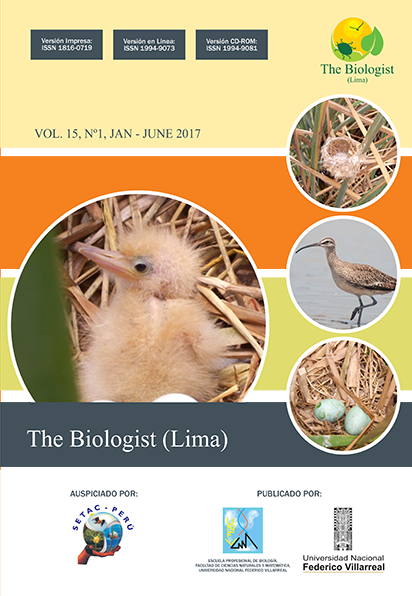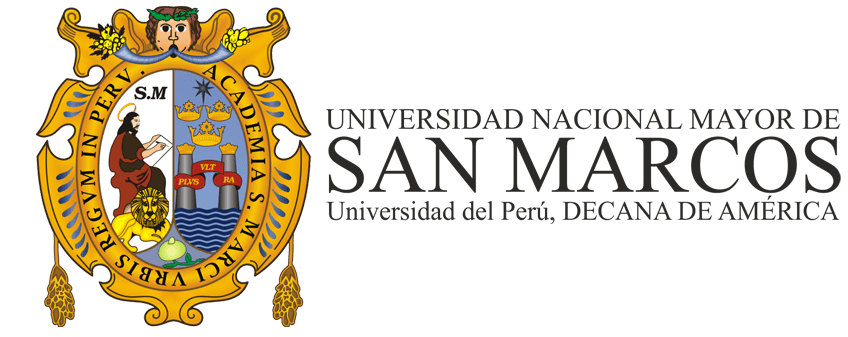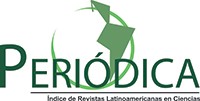DETERMINACIÓN DEL EFECTO DEL BIOCARBÓN EN MOVILIDAD DEL MERCURIO EN SISTEMA SUELO-PLANTA
DOI:
https://doi.org/10.24039/rtb2017151137Palabras clave:
activation, biochar, mercury, plant, soilResumen
La contaminación de suelos peruanos por uso indiscriminado de mercurio conlleva al riesgo de absorción del metal por las plantas cercanas a estos suelos y en consecuencia posiblemente a toda la cadena trófica del lugar. Es por eso que con esta investigación se hace un esfuerzo por encontrar soluciones costo-efectivas y amigables con el medio ambiente, como el uso de biocarbón (BC), que favorezcan la retención e inmovilización del mercurio en el suelo. El objetivo de este estudio fue determinar la eficiencia en la retención de Hg en el suelo de cuatro tipos de biocarbón compostado, evaluando las diferencias entre los diferentes tipos de biocarbón generados a dos temperaturas (300 y 680°C) y activados con adición de ácido fosfórico (0,1 L•kg-1) o no activado. Se calculó el Coeficiente de Absorción Biológica (BAC), el cual mide la distribución del metal en el sistema suelo-planta. El BAC correspondiente al biocarbón producido a alta temperatura (680°C) resultó significativamente menor con respecto al producido a baja temperatura (300°C), promoviendo la retención del metal en el suelo. El efecto del ácido fosfórico en la activación del BC no obtuvo resultados significativos en la retención del mercurio. Se observó que el BC producido a baja temperatura promovió mayor fitoextracción del mercurio por la planta. Mayor investigación es necesaria para evaluar diferentes materias primas para la fabricación de varios tipos de biocarbón con distintas propiedades y experimentar con diferentes compuestos de mercurio.Descargas
Citas
Barbieri, G. 2010. Evaluación de mercurio total en peces, agua y sedimentos en la Cuenca del Rio Malinnowky, departamento de Madre de Dios, causada por la minería aurífera aluvial. Ministerio de la Producción y Pesquería.
Beesley, L.; Moreno-Jiménez, E.; Gomez-Eyles, J. L.; Harris, E.; Robinson, B. & Sizmur, T. 2011. A review of biochars' potential role in the remediation, revegetation and restoration of contaminated soils. Environmental Pollution, 159: 3269-3282.
Beesley, L.; Inneh, O. S.; Norton, G. J.; Moreno- Jimenez, E.; Pardo, T.; Clemente, R. & Dawson J. J. C. 2014. Assessing the influence of compost and biochar amendments on the mobility and toxicity of metals and arsenic in a naturally contaminated mine soil. Environmental Pollution, 186:195-202.
Bhatnagar, A.; Hogland, W.; Marques, M. & Sillanpää, M. 2013. An overview of the modification methods of activated carbon for its water treatment applications. Chemical Engineering Journal, 219: 499- 511.
Biederman, L.A. & Harpole, S. 2013. Biochar and its effects on plant productivity and nutrient cycling: a meta-analysis. Bioenergy, 5: 202- 214.
Borchard, N.; Siemens, J.; Ladd, B.; Möller, A. & Amelung, W. 2014a. Application of biochars to sandy and silty soil failed to increase maize yield under common agricultural practice. Soil and Tillage Research, 144: 184-194.
Borchard, N.; Spokas, K.; Prost, K. & Siemens, J. 2014b. Greenhouse Gas Production in Mixtures of Soil with Composted and Noncomposted Biochars Is Governed by Char-Associated Organic Compounds. Journal of Environment Quality, 43: 971.
Bringmark, L.; Bringmark, E. & Samuelsson, B. 1998. Effects on mor layer respiration by small experimental additions of mercury and lead. Science of the Total Environment, 213: 115-119.
Chan, K. Y.; Van Zwieten, L.; Meszaros, I.; Downie, A. & Joseph, S. 2007. Agronomic values of greenwaste biochar as a soil amendment. Australian Journal of Soil Research, 45: 629.
Chan, K. Y.; Van Zwieten, L.; Meszaros, I.; Downie, A. & Joseph, S. 2008. Using poultry litter biochars as soil amendments. Australian Journal of Soil Research, 46: 437–444.
Defensoría del Pueblo. 2016. Reporte de Conflictos Sociales Nº147. Lima: Adjuntía para la prevención de Conflictos Sociales y Gobernabilidad.
ECA Suelo Perú. s. f.). Normas y guías del Perú. Recuperado a partir de http://ecasuelo. com.pe/
Forján, R.; Asencio, V.; Rodriguez-Vila, A. & Covelo, E.F. 2016. Contributions of a compost-biochar mixture to the metal sorption capacity of a mine tailing. Environmental Science and Pollution Research. 23: 2595 – 2602.
Guaman, R. 2010. Estudio biagronómico de 10 cultivares de lechuga de cabeza (Lactuca sativa), utilizando dos tipos de fertilizantes orgánicos, en el Cantón Riobamba, provincia de Chimborazo. Memoria Ingeniero Agrónomo. Escuela Superior Politécnica de Chimborazo, Facultad de Recursos Naturales. Riobamba, Ecuador.
Kabata-Pendias, A. 2011. Trace Elements in Soils and Plants. USA. Taylor & Francis Group.
Kammann, C. I.; Schmidt, H. P.; Messerschmidt, N.; Linsel, S.; Steffens, D.; Muller, C.; Koyro, H. W.; Conte, P.; Joseph, S. 2015. Plant growth improvement mediated by nitrate capture in co-composted biochar. Scientific Reports, 5: 11080.
Liou, T.H. 2010. Development of mesoporous structure and high adsorption capacity of biomass-based activated carbon by phosphoric acid and zinc chloride activation. Chemical Engineering Journal, 158: 129-142.
Liu, P.; Ptacek, C.; Blowes, D.; Paulson, K.; Ma, J. & Wang, A. O. 2014. Stabilization of mercury and methyl mercury by biochars in water/sediment microcosms. Department of Earth and Environmental Sciences. University of Waterloo. Canada.
Major, M. 2010. Guidelines on practical aspects of biochar application to field soil in various soil management systems. Biochar International.
Major, J.; Rondon, M.; Molina, D.; Riha, S.J. & Lehmmann, J. 2010. Maize yield and nutrition during 4 years after biochar application to a Colombian savanna oxisol. Plant and Soil, 333: 117-128.
Paisio, C.E.; González P.S.; Talano, M.A. & Agostini, E. 2012. Remediación biológica de mercurio: Recientes avances. Revista Latinoamericana en Biotecnología y Ambiente. 3:119-146.
Paz-Ferreiro, J.; Lu, H.; Fu, S.; Méndez, A. & Gascó, G. 2014. Use of phytoremediation and biochar to remediate heavy metal polluted soils: a review. Solid Earth. 5: 65- 75.
United Nations Environmental Program - UNEP. 2013. Global Mercury Assessment 2013: Sources, Emissions, Releases and Environmental Transport . U N E P Chemicals Branch, Geneva, Switzerland.
Sarkar, D.; Essington, M. E. & Msra, K. C. 1999. Adsorption of mercury (II) by variable charge surfaces of quartz and gibbsite. Soil Science Society of America Journal. 63: 1626–1636.
Shu, R.; Wang, Y.; Zhong, H. 2016. Biochar amendment reduced methylmercury accumulation in rica plants. J Hazard Mater 5, 313: 1-8.
Steinnes, E. 2013. Mercury. Heavy Metals in Soils. Alloway, B. J. UK. Springer.
Uchimiya, M.; Chang, S. & Klasson, K. T. 2011. Screening biochars for heavy metal retention in soil: Role of oxygen functional groups. Journal of Hazardous Materials, 190: 432-441.
USEPA. 2015. America's Children and the environment: Biomonitoring - Mercury. Estados Unidos.
Violante, A.; Huang, P. M. & Gadd, G. M. 2008. Biophysico-Chemical Processes of Heavy metals and metalloids in soil environments. Cap 5. New Jersey: John Wiley & Son, Inc.
Violante, A.; Ricciardella, M. & Pigna, M. 2003. Adsorption of Heavy Metal son Mixed Fe- Al Oxides in the Absence or Presence of Organic Ligands. Water and Soil Pollution 145: 289-306.
Violante, A. & Pigna, M. 2002. Competitive sorption of arsenate and phosphate on different clay minerals and soils. Soil Science Society of America Journal. 66: 1788–1796.
Weinberg, J. 2007. Introducción a la contaminación por mercurio para las ONG. International POP's Elimination Network – IPEN.
Windeatt, J. H.; Ross, A. B.; Williams, P. T.; Foster, P. M.; Nahil, M. A. & Singh, S. 2014. Characteristics of biochars from crop residues: Potencial for carbon sequestration and soilamendment . Journal of Environmental Management. 146: 189 - 197.
Wright, J. 2003. Environmental Chemistry. London; New York: Routledge.
Publicado
Cómo citar
Número
Sección
Licencia
Derechos de autor 2017 The Biologist

Esta obra está bajo una licencia internacional Creative Commons Atribución-NoComercial-SinDerivadas 4.0.
Objeto: El AUTOR-CEDENTE transfiere de manera TOTAL Y SIN LIMITACIÓN alguna al CESIONARIO (Revista The Biologist (Lima)) los derechos patrimoniales que le corresponden sobre sus obras por el tiempo que establezca la ley internacional. En virtud de lo anterior, se entiende que el CESIONARIO adquiere el derecho de reproducción en todas sus modalidades, incluso para inclusión audiovisual; el derecho de transformación o adaptación, comunicación pública, traducción, distribución y, en general, cualquier tipo de explotación que de las obras se pueda realizar por cualquier medio conocido o por conocer en el territorio nacional o internacional.
Remuneración: La cesión de los derechos patrimoniales de autor que mediante este contrato se hace será a título gratuito.
Condiciones y legitimidad de los derechos: El AUTOR-CEDENTE garantiza que es propietario integral de los derechos de explotación de la(s) obra(s) y en consecuencia garantiza que puede contratar y transferir los derechos aquí cedidos sin ningún tipo de limitación por no tener ningún tipo de gravamen, limitación o disposición. En todo caso, responderá por cualquier reclamo que en materia de derecho de autor se pueda presentar, exonerando de cualquier responsabilidad al CESIONARIO.
Licencia de acceso abierto: El AUTOR-CEDENTE autoriza que manuscrito publicado en la Revista Científica The Biologist (Lima) (versión Impresa ISSN 1816-0719, versión en línea ISSN 1994-9073) permanece disponible para su consulta pública en el sitio web http://revistas.unfv.edu.pe/index.php/rtb/index y en los diferentes sistemas de indexación y bases de datos en las que la revista tiene visibilidad, bajo la licencia Creative Commons, en la modalidad Reconocimiento-No comercial- Sin Trabajos derivados –aprobada en Perú, y por lo tanto son de acceso abierto. De ahí que los autores dan, sin derecho a retribución económica, a la Escuela Profesional de Biología, Facultad de Ciencias Naturales y Matemática de la Universidad Nacional Federico Villarreal (EPB - FCCNM - UNFV), los derechos de autor para la edición y reproducción a través de diferentes medios de difusión.








































